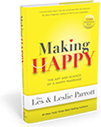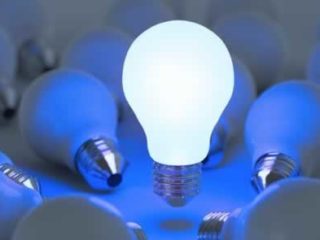My grandmother chose to do something that impacted her life and the lives of everyone she met. Despite the loss and the pain she endured in her life, she chose to look at each of us (and at total strangers, too) like we were incredibly important people. No matter how sick she was, or how hard things were, her eyes would always light up when she saw us. There was never any question that she was excited to see us.
That’s it? Just look at someone like you’re crazy about them? Well, yes.
What many top neuroscientists are discovering is that love moves at the speed of joy. When someone looks at you like you’re really valuable, it registers in your brain as joy.
Remember the song “You Light Up My Life”? It’s not just a song. Most of us don’t realize that we have the power to light up our loved ones’ lives every time we walk into a room. Or when we walk in the door after a long day at work. But we do. How we look at people matters.
Why does it matter so much?
Many people know that we have two sides of our brains, a right hemisphere and a left hemisphere. You’ve probably heard some of the related generalizations: “Right-brained” people tend to be musicians, poets, and artists, while “left-brained” people tend to be engineers, scientists, and mathematicians. But current brain science has discovered that reality is more complex. Indeed, we’re all—in many ways—both– brained people. As one neuroscientist put it, “For the most part we all use both sides of our brains almost all the time.” 1
Think about that for a moment. While different sections of the brain do specialize in certain types of thinking and response, most of our experiences—every sight, smell, taste, touch, and sound—travel through and activate both halves of our brains.
Yes, the left side of the brain is where we make decisions and formulate theories and where we store words and memories. But before anything gets there, it’s first processed on the right side of the brain—a bit like driving a car up one side of a parking lot aisle, turning left, and then heading down the next aisle at a slower speed before finding a parking spot.
It is in God’s love and blessings that one finds the ability to choose to reflect joy.
So what happens on that right side? This part of our brains is where we very quickly—even more quickly than with conscious thought—process whether an experience or observation is positive in nature. This happens before those signals move on to the left side of the brain, where we analyze those observations and file them away in long-term storage.
I know what you’re thinking. Why do these brain traffic patterns matter? How does any of this relate to two people getting married and merging their lives together?
Stay with me; we’re almost there. But first, a question: Have you ever arrived at a party or social gathering and experienced feelings of acceptance and relief when you’ve seen someone there who really likes you? You can tell they’re glad to see you even before they’ve spoken a word. How? Their eyes seem to light up! The look they give you says, “The party just got so much better! Look who’s here! Someone wonderful just walked in!”
Our ability to register that someone is happy to see us happens faster than our ability to register conscious thought, faster than we analyze and store the memory. And what a great way to remember the event! Someone was glad to see me! When we see that person look at us from across the room, our brain registers joy and acceptance. We feel good, welcome, and even excited to be there.
Now imagine walking into another room, at another time, and seeing your spouse’s face. (Just that sentence may have you wondering what reaction you’d see.) What expression would it have? What would be the first signal sent to your brain? What if, instead of anger, frustration, shame, or uncertainty, you saw joy and acceptance in your spouse’s face? Just by that initial joy-filled smile, you’d know your spouse was crazy about you.
The more I learn about the science behind this, the more I think about my grandmother. Without exaggeration, every time I can remember walking into her presence—from my earliest memories until my teens when she passed away—I can’t remember a time when she didn’t light up with sparkling eyes, even when she was weak, sick, and in her last days at the hospital.
“The light of the eyes rejoices the heart” (Proverbs 15:30). Talk about a joy magnet! Literally every time I saw my grandmother, I felt joy radiating from her. And, biochemically, it just so happens that love and attachment move at the speed of joy.
Think back again to the picture you had of your spouse “lighting up” when he or she sees you when you get home from work, when you come back after running an errand, or when you sit across from him or her at the dinner table. Each time, joy and attachment are reflected back to you. How would that change how you feel about your relationship? How would that affect your desire to spend more time in the same room with your spouse?
Please understand that this isn’t a prescription for insincerity. I’m not advising you to be like a car salesman whose eyes light up when they see you because they think it’ll help them make an easy sale. Expressing joy is linked with genuine attachment—it’s a reflection of authentic feelings. It’s also something I’ve had to repeatedly practice, even though I experienced it from others.
I grew up with a grandmother and parents who looked at me countless times as if I was incredibly special. But I also spent five years in an abusive relationship during which, through words and actions, that joy was scrubbed out of my conscious mind and replaced with feelings of shame, disgust, and worthlessness.
I am incredibly grateful that even in those tough times, my parents never bailed on me. They were committed and attached to me, keeping their hands on my shoulders. And when I finally got out of the abusive relationship, I saw how important their attachment was in bringing me back to faith and love and life.
Joy can become one of the most authentic parts of our identity
But what I’ve often struggled with is something you might also struggle with, especially if you’ve been through tough times without having any “high hill” people in your life. It’s understanding and cultivating the spirit necessary to reflect the kind of joy that radiates from who we are. Joy can become one of the most authentic parts of our identity and self, or it can be something we lose and never learn to recapture.
I’m often amazed at how science confirms and “catches up to” the Bible’s relationship advice. It shouldn’t surprise me. After all, our heavenly Father, His Son, Jesus, and the Holy Spirit were all there in the beginning. God made us. He created human relationships, and He knows what we need. He knows how we are wired to receive joy when we see the bright eyes and the warm smile of a loved one. His Word is designed to be for all times and for all people. “The grass withers, the flower fades, but the word of our God will stand forever” (Isaiah 40:8). God’s Word, like His love, lasts forever, no matter how long it takes for humans to catch up.
But here was my problem: I knew—intellectually, at least—that my terrible season of abuse had erased many of the positives in my life. I would react like I had emotional sunburn if anyone said anything that I felt was even slightly negative. I knew there were times I reflected anything but joy when people were in my presence. But what I thought would help was more information. More education. I needed to study and learn more in order to reflect joy more. Frankly, that’s what the world, even the counseling world, often tells us to do. All we need to do is get more information. The idea is that more education and more words will help you think better. And thinking better will help you change your life for the better.
But guess what? Information by itself affects only half the brain—the logical, analytical left side. And since we are designed to be both-brained people, this one-sided approach just wasn’t working for me. I couldn’t simply outthink my negative emotions. They had deep roots, and I’d often have automatic reactions to present circumstances based on my past hurts. I could recognize the positive things that I could do, and maybe even should do. But logic, reasoning, and education weren’t enough to stop my impulsive responses. What I’ve learned is that we need to do more than just know things. We need to experience those things too.
Don’t get me wrong. Knowing truth is important. But in the way God has wired us, it is not the left-brain information that truly changes us but rather the right-brain experiences of love, acceptance, and joy.
And those sorts of experiences are what have been the biggest change factors in our relationship. They’ve also led to my own growth and ability to live out joy.
So how do we experience joy? Especially in marriage?
Yes, learning about marriage tools will provide you with valuable information for building relational health. But these tools are not meant to stay on the left side of our brains! You must practice these tools with love and joy so that you can use the information and truth to bring change—to you and your loved ones.
That is exactly what I saw in my grandmother. She recognized the truth about reflecting a joyful spirit, and then she did so with love and joy. She turned head knowledge into heartfelt action. Yes, she would lie down and cry when terrible things happened to her. But I discovered she would always return to something priceless, something she discovered in God’s Word.
“Weeping may tarry for the night, but joy comes with the morning” (Psalm 30:5). There’s that word again. Joy. In God’s presence “there is fullness of joy” (Psalm 16:11).
Not knowledge or more information. Joy. For my grandmother, joy wasn’t based on the circumstances or challenges in front of her. Joy came from love. God’s love.
I spent five years in a relationship that blocked love and faith from me like a dam blocking life-giving water from flowing down to me. The dam broke when I finally moved toward focusing on God’s blessings rather than the curses of this dark world. God’s love reframed and rebuilt my life, recalibrating it toward joy.
It is in God’s love and blessings that one finds the ability—even when suffering from rheumatoid arthritis and having not slept most of the night—to choose to reflect joy when a granddaughter walks into the room. It is here in God’s blessings that I can choose joy when
I see Joey with his headlamp on again, scrubbing at a place I would have thought was clean already. It is here in God’s love that we choose joy instead of being bound by all those terrible pictures and memories stored on the left side of our brains.
Joy comes in the morning, because even through those dark nights, God’s love will be there. Always. Ready to wipe away the tears and bring light to a new day.
Adapted from The Merge for Marriage by Kari Trent Stageberg. Copyright © 2023. Used by permission of Focus on the Family. All rights reserved. Represented by Tyndale House Publishers, a Division of Tyndale House Ministries.
Get the Book!
1 Tania Lombrozo, “The Truth about the Left Brain/Right Brain Relationship,” 13.7: Cosmos and Culture, National Public Radio, December 2, 2013, https://www.npr.org/sections/13.7/2013/12/02/248089436/the-truth -about-the-left-brain-right-brain-relationship.
[schemaapprating]












